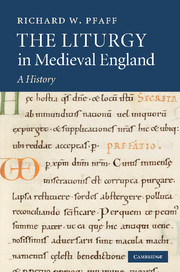Book contents
- Frontmatter
- Contents
- Preface
- Sigla and editorial conventions
- Bibliographical abbreviations
- Nicknames for manuscripts frequently referred to
- 1 Introduction
- Excursus: on sources
- 2 Early Anglo-Saxon England: a partly traceable story
- Excursus: on the terms Gregorian and Gelasian as used here
- 3 Later Anglo-Saxon: liturgy for England
- 4 The Norman Conquest: cross fertilizations
- Excursus: on method in the comparison of liturgical texts
- 5 Monastic liturgy, 1100–1215
- Excursus: on ascription of liturgical books to specific churches
- 6 Benedictine liturgy after 1215
- 7 Other monastic orders
- 8 The non-monastic religious orders: canons regular
- 9 The non-monastic religious orders: friars
- Excursus: on liturgical books from female religious houses
- 10 Old Sarum: the beginnings of Sarum Use
- 11 New Sarum and the spread of Sarum Use
- 12 Exeter: the fullness of secular liturgy
- 13 Southern England: final Sarum Use
- 14 Regional Uses and local variety
- 15 Towards the end of the story
- Index of Manuscripts
- Index of Saints
- General Index
11 - New Sarum and the spread of Sarum Use
Published online by Cambridge University Press: 20 March 2010
- Frontmatter
- Contents
- Preface
- Sigla and editorial conventions
- Bibliographical abbreviations
- Nicknames for manuscripts frequently referred to
- 1 Introduction
- Excursus: on sources
- 2 Early Anglo-Saxon England: a partly traceable story
- Excursus: on the terms Gregorian and Gelasian as used here
- 3 Later Anglo-Saxon: liturgy for England
- 4 The Norman Conquest: cross fertilizations
- Excursus: on method in the comparison of liturgical texts
- 5 Monastic liturgy, 1100–1215
- Excursus: on ascription of liturgical books to specific churches
- 6 Benedictine liturgy after 1215
- 7 Other monastic orders
- 8 The non-monastic religious orders: canons regular
- 9 The non-monastic religious orders: friars
- Excursus: on liturgical books from female religious houses
- 10 Old Sarum: the beginnings of Sarum Use
- 11 New Sarum and the spread of Sarum Use
- 12 Exeter: the fullness of secular liturgy
- 13 Southern England: final Sarum Use
- 14 Regional Uses and local variety
- 15 Towards the end of the story
- Index of Manuscripts
- Index of Saints
- General Index
Summary
The ideal equipment for consideration of the fully developed Sarum mass-rite would be three pairs of manuscript books, a missal and an ordinal: a pair each to represent the circumstances there at roughly the ends of the twelfth, thirteenth, and fourteenth centuries; and then a printed missal of the end of the fifteenth. As should be clear from the previous chapter, the first putative pair simply does not exist. There is neither anything that can be fairly called a Sarum missal surviving from the twelfth century – that is, a massbook of the kind that would have been in use at Old Sarum – nor a separate ordinal from that period. Lacking these, we have had to perform a good deal of rather wearisome extrapolation to get at elements of some sanctorale texts which look to be discernible as “Sarum” peculiarities, though not identified as such. Two hundred or so years later, by the end of the fourteenth century, a high degree of both elaboration and standardization seems to have been reached, and the very full rubrics which reflect what we shall study as the New Ordinal are widely copied into missals. When books with unambiguous titles like Missale ad usum insignis et praeclarae ecclesiae Sarum begin to be printed at the end of the fifteenth (the two earliest are 1487 and 1492), the relevant material from ordinals has been thoroughly incorporated into the text of the missal.
The present chapter aims to sketch the outlines of a picture that might be representative of the situation in, say, about 1290.
- Type
- Chapter
- Information
- The Liturgy in Medieval EnglandA History, pp. 365 - 387Publisher: Cambridge University PressPrint publication year: 2009

